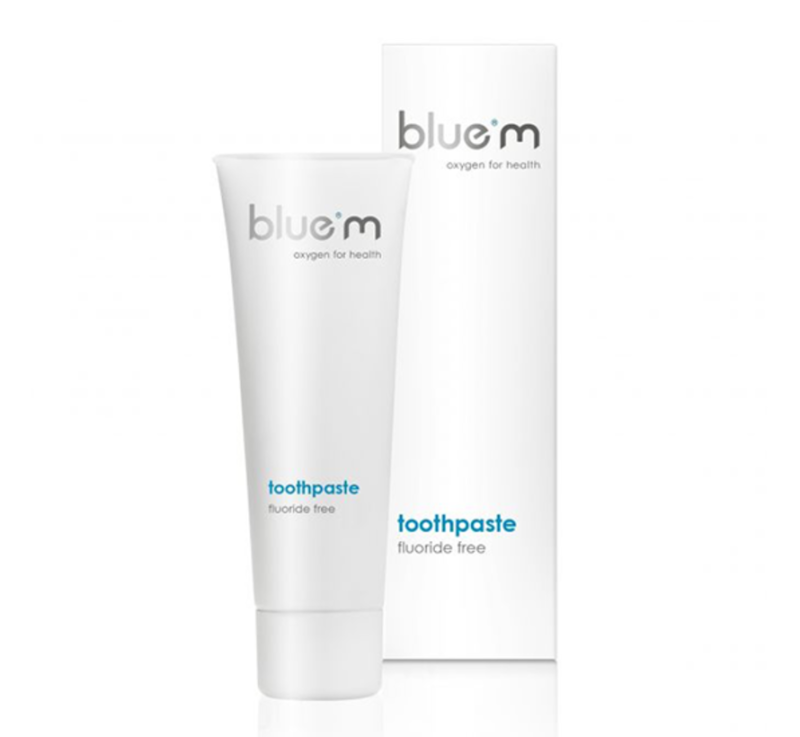Toothpaste fluoride free
Choose the healthy alternative: blue®m toothpaste, oxygen for health!
Toothpaste without fluoride
blue®m toothpaste, specially developed by a team of implantologists, oral surgeons and dentists, contains active oxygen derived from honey amongst others. Consequently, bluem® is different from other toothpastes and very effective.
blue®m fluoride free toothpaste is elected by consumers as ‘Best Product of the Year 2017/2018‘
bluem® toothpaste without fluoride is also excellent fit for the care of implants. Fluoride affects the titanium layer of the implant. That is why we recommend using fluoride free toothpaste. Our fluoride free toothpaste is PH-neutral and does not contain abrasive components. This helps prevent damage on implants and crowns.
We’ve changed the name of this product, the toothpaste is also known as ‘implant care’. Same product, same taste, same results, yet different packaging. It’s possible you still find the ‘old’ packaging, don’t worry!
Preventive and for specific oral problems
Use bluem® toothpaste for prevention and maintenance (of regular teeth and implants). It helps to keep teeth and gums healthy. Dentists advise using bluem® toothpaste when the following problems occur:
Instructions
You can use our toothpaste in the same way as normal toothpaste. Brush your teeth and implants every day with bluem® toothpaste. Preferably this should be after every meal and/or at least twice a day. Use an extra or ultra soft tooth brush and make sure to put it in the right angle for the most effective results. Be careful with the soft tissues in your mouth.
A healthy mouth is essential for a healthy body! That’s why doctor Peter Blijdorp advises to brush with his unique oxygen-based formula after each meal.
Why bluem® fluoride free toothpaste?
- helps teeth and gums to stay healthy
- perfect for implant maintenance
- pH-neutral, free of abrasive components
- contributes to preservation of white teeth, reduces color difference
- toothpaste for daily use
- for prevention and acute oral problems

toothpaste travel kit
Keep on brushing with bluem®, even on holiday, 5 small toothpastes, without fluoride (15 ml each)
- allowed on the plane
- helps maintain a beautiful smile
- normalises and controls harmful bacteria on teeth, gums and implants
- free of fluoride and abrasive components
- for regular oral care
Order the handy travel pack also easy with your smartphone.

Ingredients
bluem® toothpaste without fluoride contains the following ingredients:
Glycerin, Aqua, Hydrated Silica, Mel, Silica, PEG-32, Aroma, Cocamidopropyl Betaine, Cellulose Gum, Magnesium Sulfate, Sodium Citrate, Citric Acid, Sodium Carbonate Peroxide, Sodium Saccharin, Xylitol, Methyl Salicylate, Sodium Chloride, Sodium Methylparaben, Lactoferrin, Sodium Sulfate, Phenethyl Alcohol, Caprylyl Glycol, Limonene, CI 42090.
Frequently asked questions bluem® toothpaste with active oxygen
How often should I brush for the best results?
The best results belong to a disciplined daily routines performed with attention and care. Dr. Peter Blijdorp advises to brush 2 to 3 times a day with bluem® toothpaste.
What’s the effect of honey in toothpaste?
The biological honey used in bluem® toothpaste and mouthwash gradually releases oxygen when it comes into contact with the saliva in the mouth. That process is called Glucose Oxidase (GOX).
Honey also has the following effects: normalises and controls the six most common oral bacteria. These bacteria can cause periodontitis and peri-implantitis. In addition honey also helps to reduce plaque formation.
What is Xylitol and what are the effects?
Xylitol is a natural sweetener, which is found in fibers of many fruits and vegetables. Because Xylitol is hardly converted to acid, it is less harmful to teeth than sugar or other sweeteners. Xylitol has a positive effect on teeth and molars. In the U.S. xylitol is recommended by the FDA (Food and Drug Administration) as a remedy for tooth decay.
Because the bacteria in the mouth that are causing cavities are unable to digest xylitol, their growth is greatly reduced. The number of acid-producing bacteria may fall as much as 90%. No acid is formed because the pH of saliva and plaque does not fall. After taking xylitol, the bacteria do not stick well on the surface of the teeth and as a result, the amount of plaque decreases.
Research has shown that the use of xylitol also helps repair damage to the enamel.
The use of Xylitol during pregnancy does not present a risk. Since gum disease is linked to preterm birth it can be beneficial to consume xylitol during pregnancy.
You only need a teaspoon and a half of xylitol for dental health (approximately 6.5 grams).

